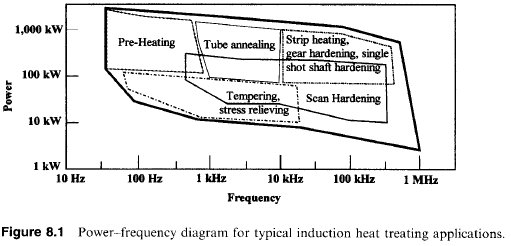Induction Furnace Power Electronics Design Rationale and Specification
See also [[1]]
Design Rationale
The Induction Furnace power supply is one of the applications of the Universal Power Supply.
This specification is for the power electronics and controls component only - other components being the heating coil with cooling system, and the melt chamber proper. It includes feedback on temperature and maximum-power-delivery tracking to the melt. This is a frequency and power level selectable power supply with automatic feedback for controlling an optimum melt sequence.
The concept is to design a stackable power supply where power supply modules may be stacked - just like the stackability of the Stackable Inverter. This way, experimental units from 1kW power up to 200kW of power (village scale) may be created via stacking. The design is intended to feature plug-and-play power modules and connections, where transparency and user serviceability are the key design features. Off-shelf, turnkey components should be utilized. If possible, an Arduino controller should be utilized as the logic unit to maximize interchangeability of components with the remainder of the Global Village Construction Set. The price mark for the dedicated electronics component of the induction furnace should be under $50/kW of power delivered to the melt. This assumes modularity and flexible (non-dedicated use) nature of the Universal Power Supply.
Why is this significant? A low cost induction furnace can be powered by electrical power generated via modern steam engines burning pelletized biomass. This allows for the taking of scrap steel, melting it - and hot rolling it to make virgin steel for other GVCS equipment. With precision machining included, this allows one to build a device like the tractor at the cost of scrap steel + labor, or for about $500 in parts in the DIY scenario, whereas formerly the cost was $6k.
Specifications
- Power output: 12.5 KW (running from a 2 ton battery bank of 3 forklift batteries at 24v each for testing purposes)
- Rated continuous maximum power output - 25kW
- Output Voltage: 300 V or whatever is required for an efficient melt
- Output Frequency: 1 KHz - 30 KHz
- Input voltage: 24 VDC or 72 VDC
- Input current: 500 A or 170 A
- Duty cycle: 100%
- Efficiency: 95+%
- Stackable in power for up to 250kW of continuous power
Particulars
- IGBT Technology and control
- Temperature controllable
- Arduino brain unit is utilized if possible
- Any heating coil geometry and any melt chamber geometry can be fitted to the power supply
- Plug-and-play, transparent design allows for easy diagnosis and replacement of power electronics components.
- Length of operation - up to 24 hrs
